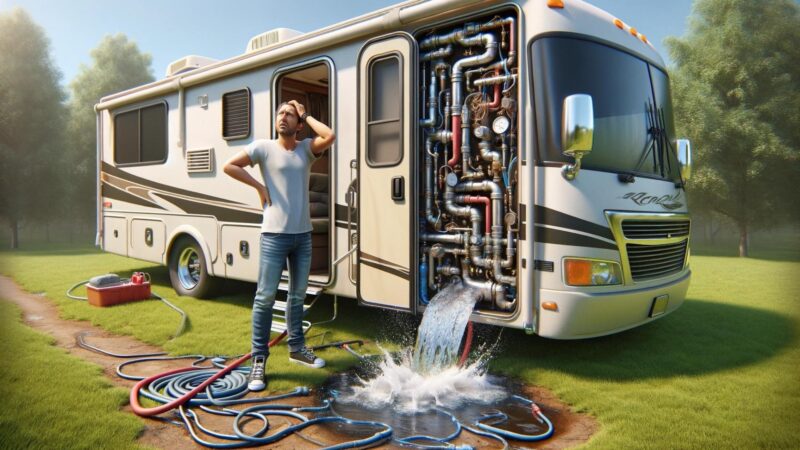Table of Contents Show
Understanding your RV plumbing system is important. Whether you have a travel trailer, fifth wheel, motorhome, or camper van, you need to know some basic details about how to get hot water, how to dump your waste tanks, and where the water goes after flushing the toilet to make your camping experience smoother.
Let’s dive in and learn more about your RV plumbing system!
Do RVs Have Plumbing Systems?
Self-contained RVs have plumbing systems. Campers or trailers that don’t have a sink, shower, or flushing toilet won’t have a plumbing system. But if you have running water, there has to be somewhere for it to come in and go out.
What Are the Parts of an RV Plumbing System?
You won’t find a lot of parts to your RV plumbing system. It’s a pretty simple setup.
Let’s look at the fixtures, water pump, water heater, and waste tanks that help get water from the source to your faucet.
Fixtures
The fixtures in your RV may look similar to the fixtures in your house.
In fact, you can replace your RV plumbing fixtures with residential ones if you’d like.
You’ll have faucets at the sinks, a showerhead, and fittings to connect the fixtures to the pipes.
A trip to the plumbing section of the nearest hardware store will provide plenty of options for updating the look of your RV. Or if a fixture goes bad, you don’t have to go to a camping store to replace it.
Head to Lowe’s, Home Depot, Ace Hardware, or even Walmart.
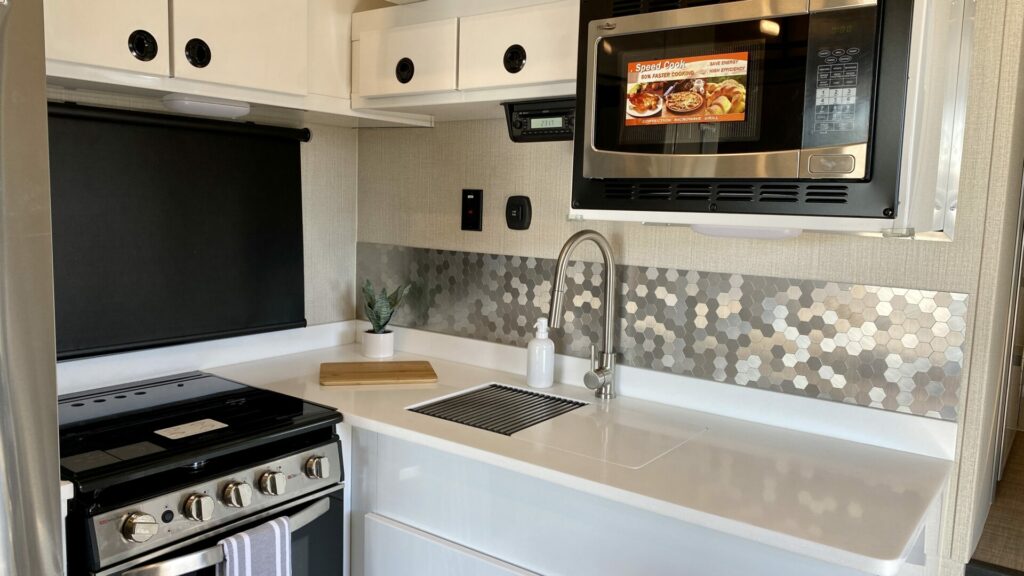
Water Pump
The water pump is an essential component of your RV plumbing system. Without it, you won’t have access to water when dry camping.
When you rely on water from your freshwater tank rather than the campground faucet, the water pump pressurizes your RV plumbing system.
The pump draws water from the freshwater tank and delivers it to the fixture you turn on.
We’ve written several articles about water pumps, so check out “What Is an RV Water Pump and How Does It Work?” and “How Does an RV Freshwater System Work?” to learn more!
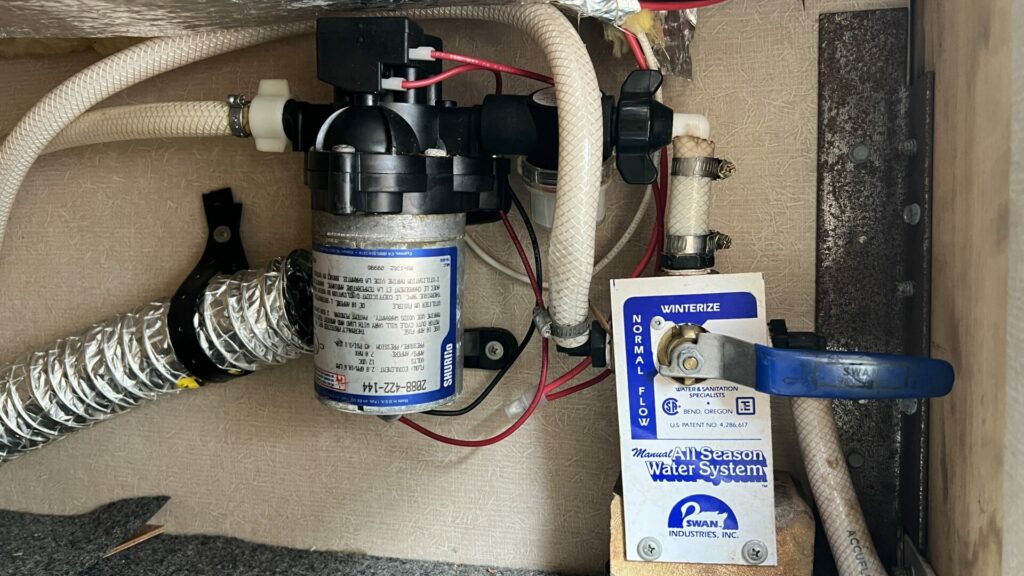
Water Heater
To receive hot water, your RV has a heating element in the water heater.
When you turn on the hot water at the faucet, water passes through the water heater.
You’ll need to turn on the water heater power switch inside your RV before attempting to get hot water.
Don’t be alarmed if you don’t get hot water right away. The water might take a while to warm if you don’t have an on-demand water heater since it needs to heat up the tank of water.
A tip we have used in the past to heat the water fast when hooked up to power is to put both the propane heat and the electric heater on simultaneously.
Some water heaters have an anode rod that reduces corrosion inside the tank. This rod must be replaced every so often. Check out our article “How and When to Change Your RV Water Heater Anode Rod” to learn more!
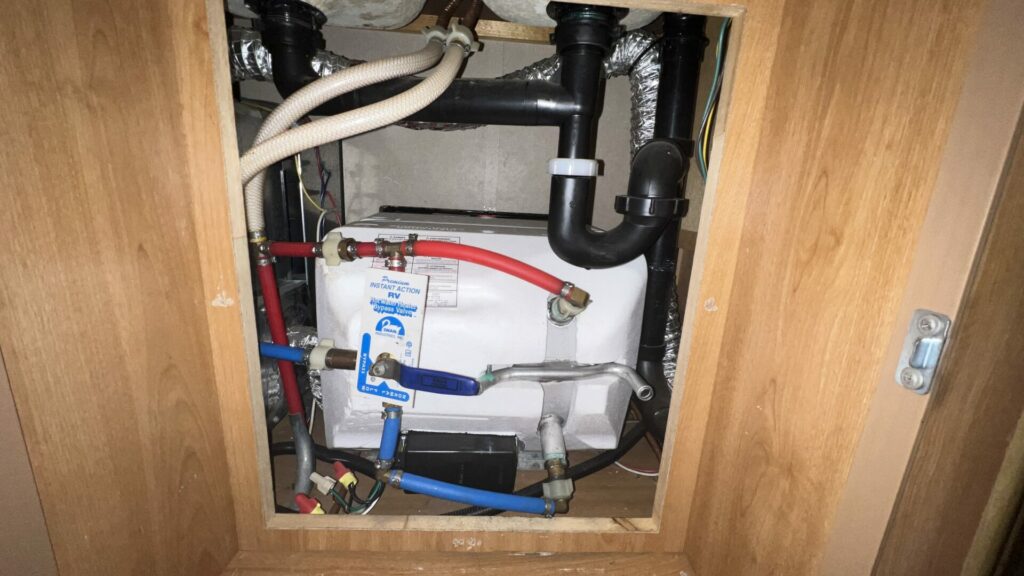
Waste Tanks
Finally, self-contained RVs must have waste tanks to collect the water that goes into the drains.
Water and waste from the toilet go into the black tank, and water from the sinks and shower goes into the gray tank.
These waste tanks are usually secured underneath the RV and out of sight.
When they’re full, you must empty them into a dump station or sewer connection.
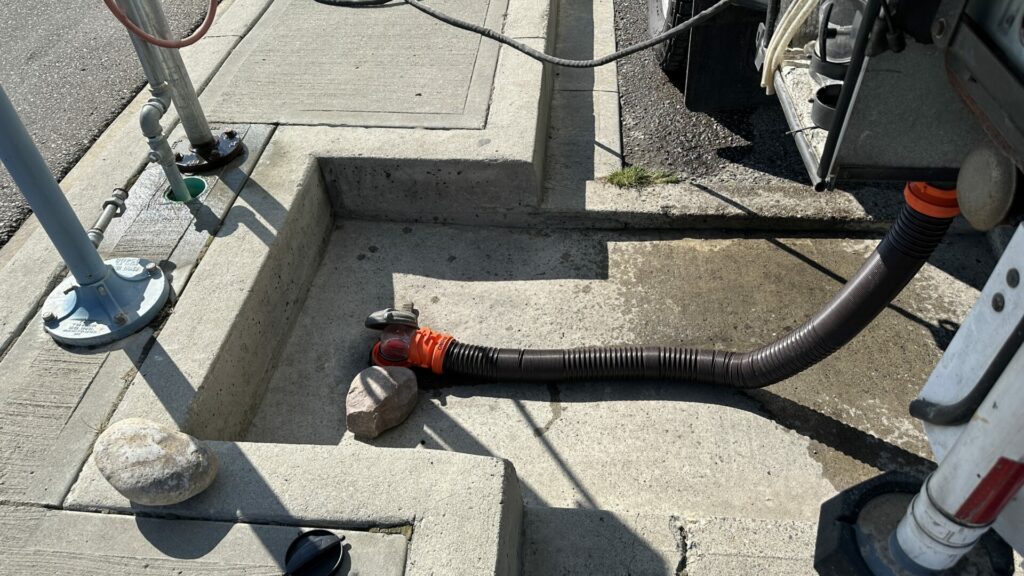
How Does the RV Plumbing System Work?
Now that we’ve explained the various components of your RV plumbing system let’s look at how they work together.
If you’re hooked up to a water connection at a campground, you’ll have a hose running from the water faucet at the campsite to your RV.
If you’re not hooked up to a water connection, you’ll need to fill your RV’s freshwater tank to access water.
When Hooked Up to Water
When you’re connected to a city water faucet at the campsite, your RV plumbing system operates similarly to your house plumbing system.
Water runs from the connection through your hose into the RV, through the pipes, and to your faucets.
You need a drinking water-safe hose to connect to the city water supply at the campsite.
The other end connects to the freshwater inlet of your RV. This is usually in one of the outdoor storage bays.
The valve at the spigot pressurizes the RV plumbing lines when it’s turned on.
There’s nothing else you have to do to get water to your faucets.
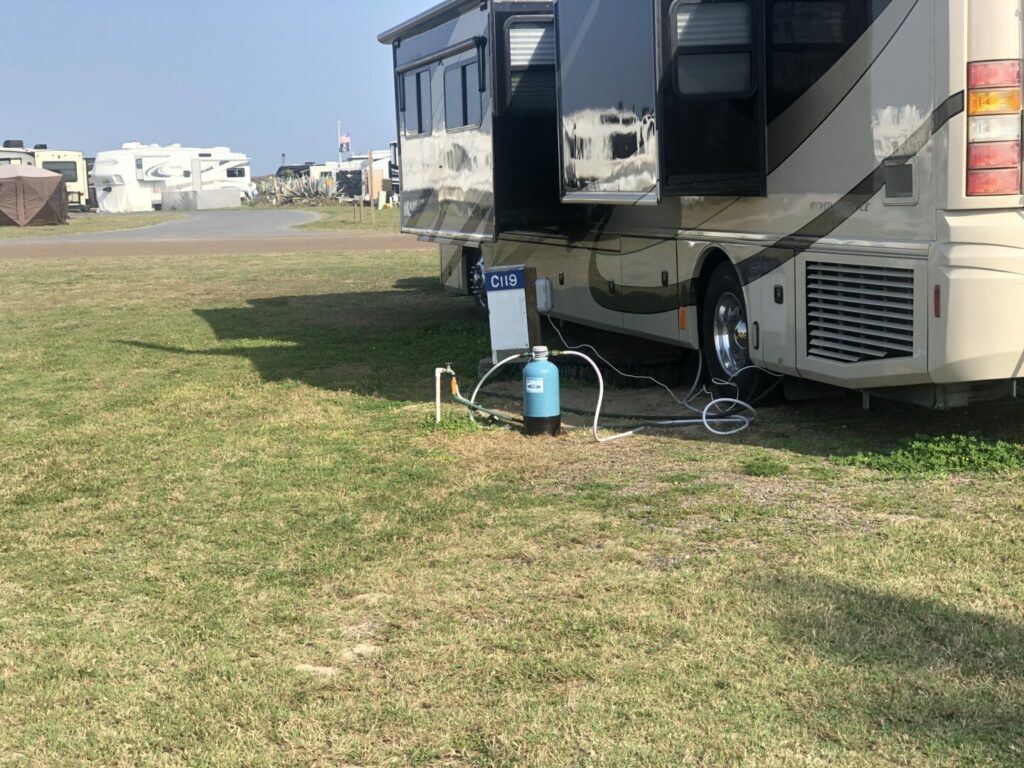
When Not Hooked Up to Water
When you don’t have the city water hookup, your RV plumbing system works a bit differently.
Your freshwater tank needs to have water in it.
If it doesn’t, you’ll first have to fill it before getting water through your plumbing lines to the faucets.
As mentioned above, this is when the water pump becomes a critical component.
When turned on, the lines pressurize to move water from the freshwater tank to the faucet.
Water will begin sputtering, and your pump will churn more when the fresh water tank gets low as it sucks up air.
You’ll need to refill it to continue to have water.
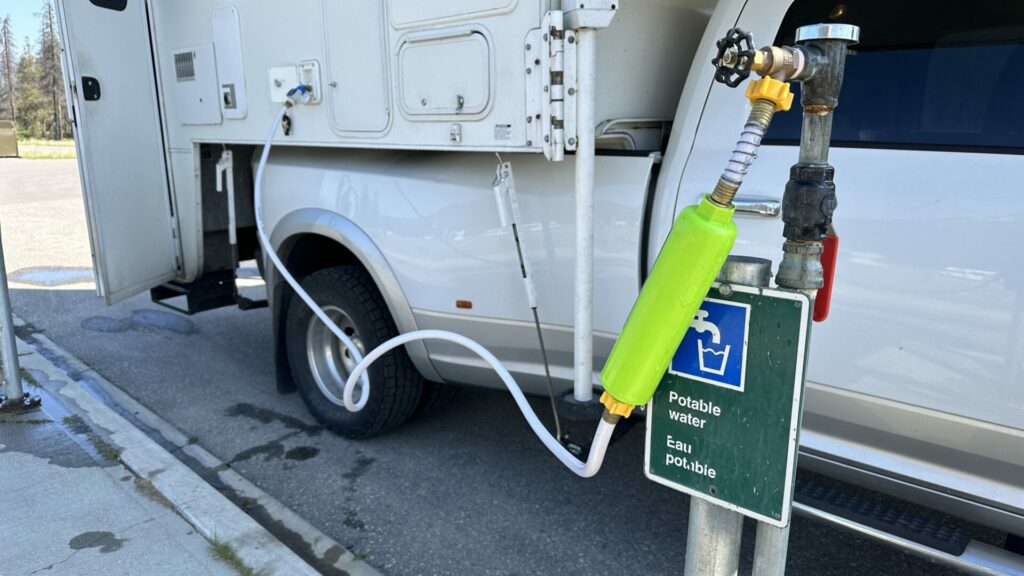
How Do You Empty Your Tanks When Connected to a Sewer?
We mentioned that waste tanks are integral to your RV plumbing system. When they’re full, you have to empty them.
At a campsite with a sewer connection, this is simple.
Your sewer hose runs from your RV’s black and gray tank connection to the ground where the hole is located.
You pull the waste gate valve, and all your waste goes pouring through the hose into the sewer underground.
You close the valve once the water ceases running through the sewer hose.
We suggest always emptying your black tank first. After emptying it, close the valve and pull it to your gray tank.
This water will flush out all the solids and gunk that might have gotten stuck in your hose from the black tank.
Then, when the water slows to a trickle, close the gray tank valve.
Dumping your tanks should only take a few minutes.
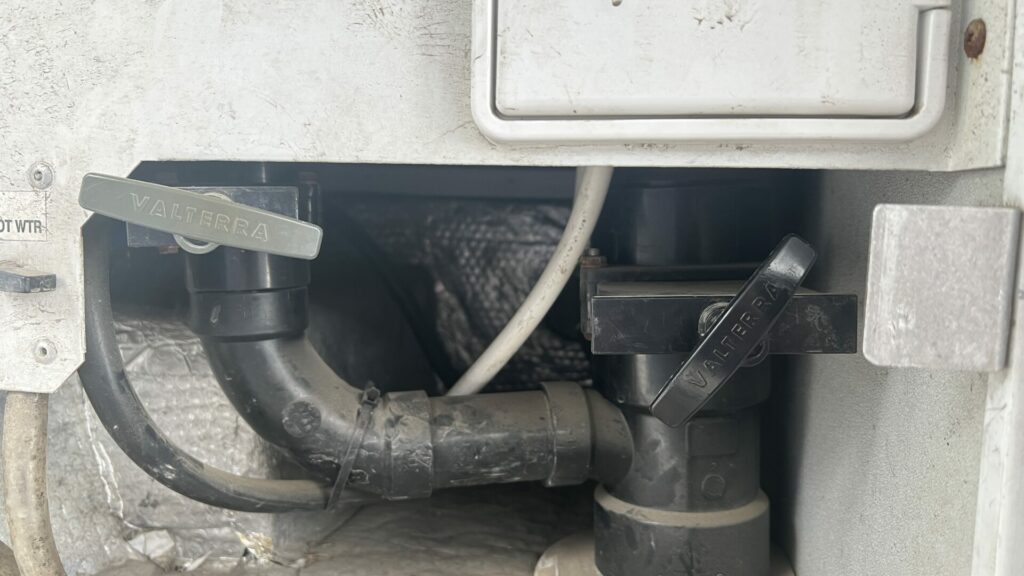
How Do You Empty Your Tanks When Not Connected to a Sewer?
You can’t dump your tanks as easily if you aren’t connected to a sewer, and you’ll find few options if you’re boondocking.
You can buy a portable waste tank that you can empty your waste tanks into and then tote it to a dump station. But if you’re camping at a state or national park, there’s likely a dump station on the property.
You could also take your RV directly to the dump station to empty the tanks.
If you do this, you will follow the same procedure when connected to the sewer.
You’ll get out your sewer hose, connect it to the hole in the ground, empty your tanks, put your sewer hose away, and then return to your campsite.
If you don’t have slides, this isn’t too much trouble. But if you have a large rig or multiple slides, investing in a portable waste tank will make things much easier.
We don’t suggest emptying your gray tank on the ground. Although some places may allow it, this practice is frowned upon and can damage vegetation and attract animals. And absolutely never dump your black tank on the ground!
Do You Need a Water Pressure Regulator for Your RV Plumbing?
We highly recommend getting a water pressure regulator for your RV plumbing system.
Some city water systems will send out water at a pressure higher than your plumbing system can handle. You never know what kind of pressure you’ll find at each campsite.
So, it’s best to stay safe and protect your water lines. In addition, should you damage your plumbing system because of high water pressure, it’s a costly mess to clean up.
Therefore, spend a little money to get a water pressure regulator. Set it around 40 psi or whatever your RV manufacturer recommends.
This small gadget will give you peace of mind when you connect to city water.
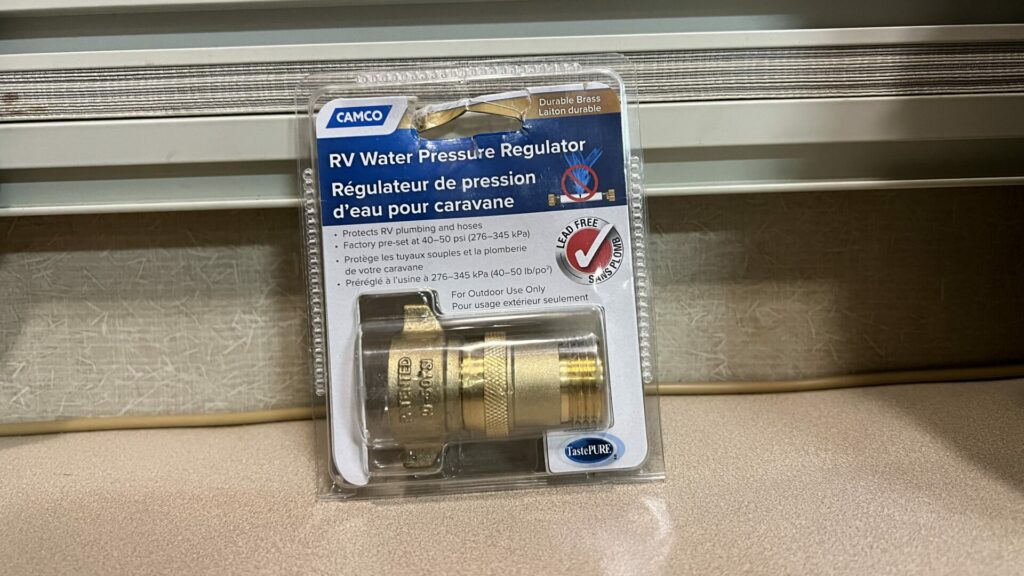
Can You Replace Your RV Plumbing Parts?
If you don’t like the look of your sink faucet, replace it with something you find more stylish.
If you boondock often and want a low-flow showerhead to conserve water, replace the standard one with one that better suits your camping style.
Feel free to replace your RV plumbing parts with residential ones.
As for the plumbing side, many people have replaced the plastic pex connectors with brass on the freshwater side. Some have even replaced the flexible hoses that some manufacturers use with standard residential pex.
You can even replace the drain plumbing as well. Most manufacturers use ABS, which can be found in your local hardware store, depending on what part of the country you are in. I know I didn’t have an issue finding it on the West Coast, but it was nowhere to be found here in Florida.
Camp With an Understanding of Your RV Plumbing System
Your RV plumbing system plays a critical role in your camping adventures. You need water to wash dishes, take showers, brush your teeth, and flush the toilet. We hope you feel more confident in how your RV plumbing system works, why each component is necessary, and how to empty your waste tanks when full.
You want to be comfortable camping at a full hookup resort or boondocking in the desert. If you have any questions about your RV plumbing system, please ask us in the comments below!
Do you have any more tips for taking care of an RV plumbing system?




